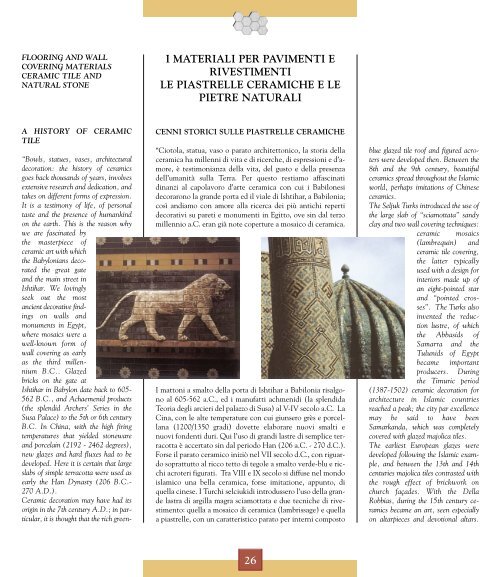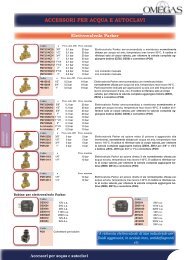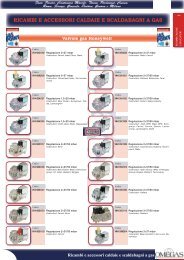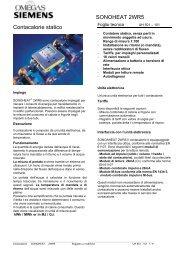i materiali per pavimenti e rivestimenti le piastrelle ceramiche e
i materiali per pavimenti e rivestimenti le piastrelle ceramiche e
i materiali per pavimenti e rivestimenti le piastrelle ceramiche e
Create successful ePaper yourself
Turn your PDF publications into a flip-book with our unique Google optimized e-Paper software.
FLOORING AND WALL<br />
COVERING MATERIALS<br />
CERAMIC TILE AND<br />
NATURAL STONE<br />
I MATERIALI PER PAVIMENTI E<br />
RIVESTIMENTI<br />
LE PIASTRELLE CERAMICHE E LE<br />
PIETRE NATURALI<br />
A HISTORY OF CERAMIC<br />
TILE<br />
CENNI STORICI SULLE PIASTRELLE CERAMICHE<br />
“Ciotola, statua, vaso o parato architettonico, la storia della<br />
ceramica ha mil<strong>le</strong>nni di vita e di ricerche, di espressioni e d’amore,<br />
è testimonianza della vita, del gusto e della presenza<br />
dell’umanità sulla Terra. Per questo restiamo affascinati<br />
dinanzi al capolavoro d’arte ceramica con cui i Babilonesi<br />
decorarono la grande porta ed il via<strong>le</strong> di Ishtihar, a Babilonia;<br />
così andiamo con amore alla ricerca dei più antichi re<strong>per</strong>ti<br />
decorativi su pareti e monumenti in Egitto, ove sin dal terzo<br />
mil<strong>le</strong>nnio a.C. eran già note co<strong>per</strong>ture a mosaico di ceramica.<br />
I mattoni a smalto della porta di Ishtihar a Babilonia risalgono<br />
al 605-562 a.C., ed i manufatti achmenidi (la sp<strong>le</strong>ndida<br />
Teoria degli arcieri del palazzo di Susa) al V-IV secolo a.C. La<br />
Cina, con <strong>le</strong> alte tem<strong>per</strong>ature con cui giunsero grès e porcellana<br />
(1200/1350 gradi) dovette elaborare nuovi smalti e<br />
nuovi fondenti duri. Qui l’uso di grandi lastre di semplice terracotta<br />
è accertato sin dal <strong>per</strong>iodo Han (206 a.C. - 270 d.C.).<br />
Forse il parato ceramico iniziò nel VII secolo d.C., con riguardo<br />
soprattutto al ricco tetto di tego<strong>le</strong> a smalto verde-blu e ricchi<br />
acroteri figurati. Tra VIII e IX secolo si diffuse nel mondo<br />
islamico una bella ceramica, forse imitazione, appunto, di<br />
quella cinese. I Turchi selciukidi introdussero l’uso della grande<br />
lastra di argilla magra sciamottata e due tecniche di rivestimento:<br />
quella a mosaico di ceramica (lambrissage) e quella<br />
a piastrel<strong>le</strong>, con un caratteristico parato <strong>per</strong> interni composto<br />
“Bowls, statues, vases, architectural<br />
decoration: the history of ceramics<br />
goes back thousands of years, involves<br />
extensive research and dedication, and<br />
takes on different forms of expression.<br />
It is a testimony of life, of <strong>per</strong>sonal<br />
taste and the presence of humankind<br />
on the earth. This is the reason why<br />
we are fascinated by<br />
the masterpiece of<br />
ceramic art with which<br />
the Babylonians decorated<br />
the great gate<br />
and the main street in<br />
Ishtihar. We lovingly<br />
seek out the most<br />
ancient decorative findings<br />
on walls and<br />
monuments in Egypt,<br />
where mosaics were a<br />
well-known form of<br />
wall covering as early<br />
as the third mil<strong>le</strong>nnium<br />
B.C.. Glazed<br />
bricks on the gate at<br />
Ishtihar in Babylon date back to 605-<br />
562 B.C., and Achaemenid products<br />
(the sp<strong>le</strong>ndid Archers’ Series in the<br />
Susa Palace) to the 5th or 6th century<br />
B.C. In China, with the high firing<br />
tem<strong>per</strong>atures that yielded stoneware<br />
and porcelain (2192 - 2462 degrees),<br />
new glazes and hard fluxes had to be<br />
developed. Here it is certain that large<br />
slabs of simp<strong>le</strong> terracotta were used as<br />
early the Han Dynasty (206 B.C.-<br />
270 A.D.).<br />
Ceramic decoration may have had its<br />
origin in the 7th century A.D.; in particular,<br />
it is thought that the rich greenblue<br />
glazed ti<strong>le</strong> roof and figured acroters<br />
were developed then. Between the<br />
8th and the 9th century, beautiful<br />
ceramics spread throughout the Islamic<br />
world, <strong>per</strong>haps imitations of Chinese<br />
ceramics.<br />
The Seljuk Turks introduced the use of<br />
the large slab of “sciamottata” sandy<br />
clay and two wall covering techniques:<br />
ceramic mosaics<br />
(lambrequin) and<br />
ceramic ti<strong>le</strong> covering,<br />
the latter typically<br />
used with a design for<br />
interiors made up of<br />
an eight-pointed star<br />
and “pointed crosses”.<br />
The Turks also<br />
invented the reduction<br />
lustre, of which<br />
the Abbasids of<br />
Samarra and the<br />
Tulunids of Egypt<br />
became important<br />
producers. During<br />
the Timuric <strong>per</strong>iod<br />
(1387-1502) ceramic decoration for<br />
architecture in Islamic countries<br />
reached a peak; the city par excel<strong>le</strong>nce<br />
may be said to have been<br />
Samarkanda, which was comp<strong>le</strong>tely<br />
covered with glazed majolica ti<strong>le</strong>s.<br />
The earliest European glazes were<br />
developed following the Islamic examp<strong>le</strong>,<br />
and between the 13th and 14th<br />
centuries majolica ti<strong>le</strong>s contrasted with<br />
the rough effect of brickwork on<br />
church façades. With the Della<br />
Robbias, during the 15th century ceramics<br />
became an art, seen especially<br />
on altarpieces and devotional altars.<br />
26

















